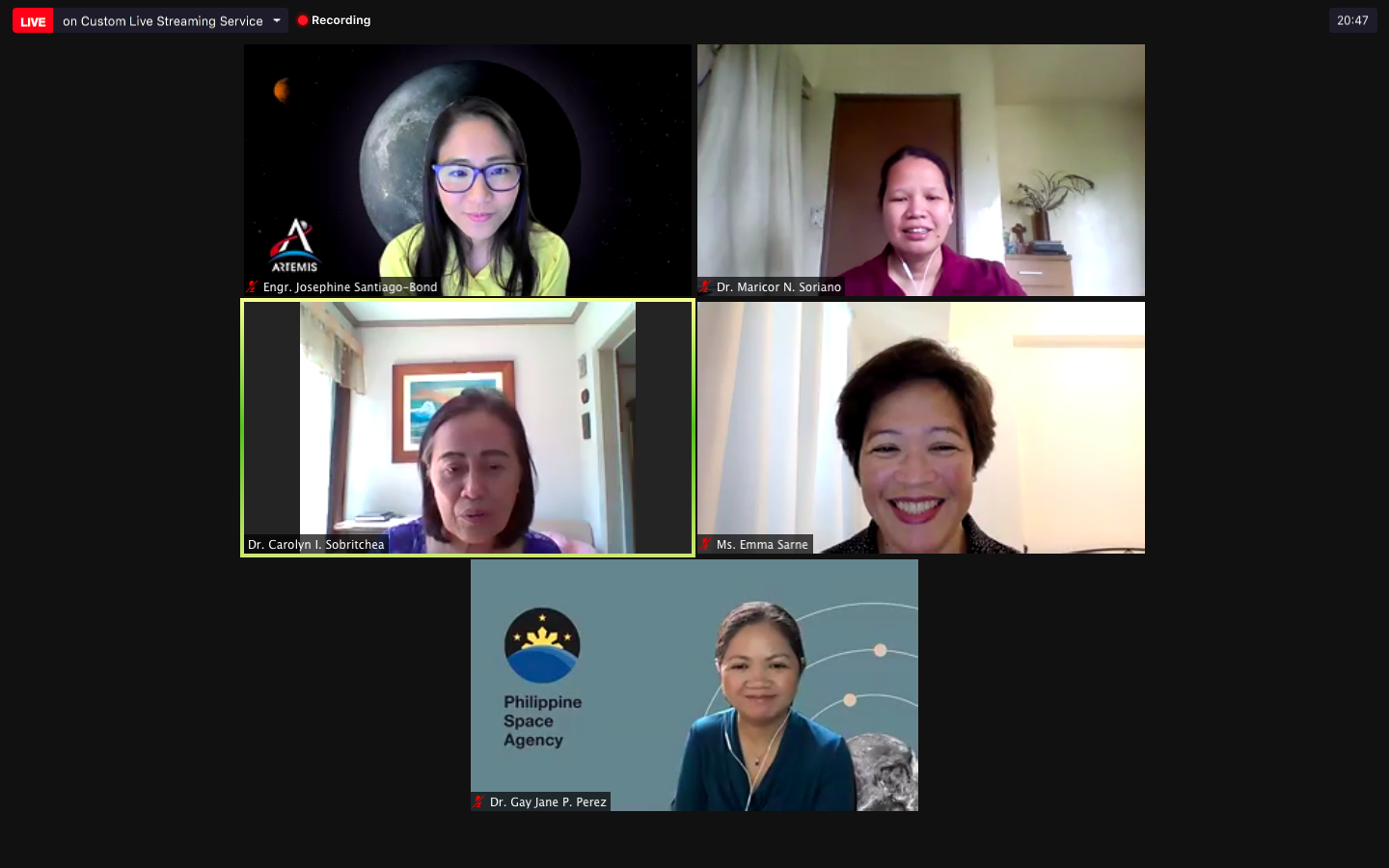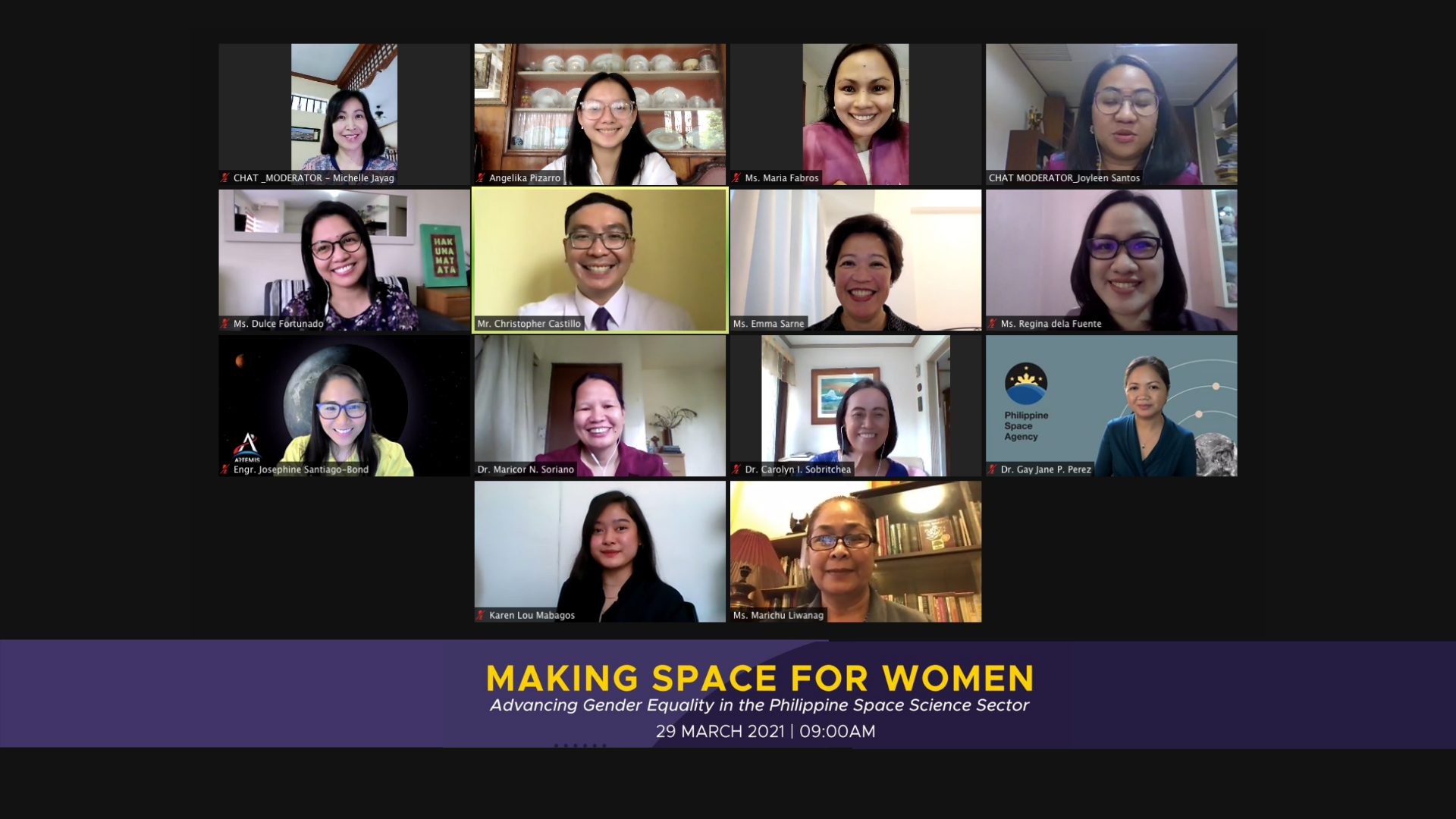Accomplished Filipino women in Science, Technology, Engineering, and Mathematics (STEM) are breaking through the glass ceiling all the way to space. This Global Astronomy Month, they’re urging more women to reach for the stars.
This is the key call to action discussed during a webinar, entitled, “Making Space for Women” held on 29 March 2021 by the Department of Foreign Affairs’ Office of the United Nations and International Organizations, in coordination with the Philippine Permanent Mission to the United Nations in Vienna, the Foreign Service Institute (FSI) Philippines, the DOST-Science and Technology Information Institute (DOST-STII), the Philippine Space Agency (PhilSA), and the Department of Education (DepEd).
The resource persons were NASA’s Kennedy Space Center Chief Engr. Josephine Santiago-Bond, PhilSA Deputy Director General Dr. Gay Jane P. Perez, DOST STAMINA4Space Program Leader Dr. Maricor N. Soriano, CHED Technical Panel for Gender and Women’s Studies Chair Dr. Carolyn I. Sobritchea, and UN Office for Outer Space Affairs (UNOOSA) Program Management Officer Markus Woltran.
The speakers shared stories on what it is like for women advancing their careers in the field of space science and technology—an area still dominated by men—and how gender gaps are dragging growth in this industry.

L-R from the top: Engr. Josephine Santiago-Bond (Chief of NASA’s Kennedy Space Center), Dr. Maricor N. Soriano (STAMINA4Space Program Leader), Dr. Carolyn I. Sobritchea (CHED Technical Panel for Gender and Women’s Studies Chair), Director Emma Sarne (Host, Department of Foreign Affairs), Dr. Gay Jane P. Perez (PhilSA Deputy Director General)
Bridging the gender gaps
On the entire planet, women account for less than 30% of people in STEM. The Philippines seems to be doing better because almost half of science practitioners are women. However, most of them are in the health sector. The numbers are still low in the field of Information Technology (I.T.) and Engineering. For example, a 2016-2017 enrolment data from CHED revealed that female enrollees in I.T. courses were only at 2.6%.
“Have you ever walked into a room and just felt different? Alone, maybe? I can tell you from experience—that in the workplace, in my case, the research program I handle is filled with men especially in Engineering and Physics. I know well that I, along with many other women, are also equally qualified and qualified to be here. But I don’t really see a lot of people like me as much as I see men,” Dr. Perez of PhilSA said.
She adds that most girls are less inclined to pursue careers in STEM because of the lack of supportive environments. Dr. Perez cited that her personal journey as a Physics major pursuing postdoctoral studies at the NASA Goddard Flight Center would not have been possible without the support of both women and men who believed in her.
“Imagine if this supportive environment can be found in yours, and in every institution,” Perez said.
Unboxing gender stereotypes
An MIT study reveals that we still have a long way to go in building supportive environments for women in science. According to the survey, factors affecting career mobility in STEM include: gender bias in hiring preferences, sexual harassment, hostility toward maternal considerations, marriage, and childbirth.
“They weren’t giving me trips because they assumed that I did not want to travel because I had a baby,” recalls Engr. Santiago-Bond.
Her advice for those with similar experience is to unburden themselves of the “negative self-talk” coming from deeply seethed gender stereotypes, and be assertive: “be explicit with what you want. Someone else was making a decision for me on travel and opportunities. I was going to make it work because I wanted to,” Engr. Santiago-Bond said.
Dr. Sobritchea of CHED points out that the field of employment is a barrier in itself. She says, aside from encouraging young girls to chase their dreams, there needs to hold more dialogue with the industry: “we need to engage the industry to make the field more women-friendly so that girls are encouraged to study, to go into the field.”
Normalizing women in science
History never failed to give prominence to women who, despite the many obstacles during their time, managed to make a mark in science and technology. Katherine Johnson, Marie Curie, and Rosalind Franklin, continue to inspire many young girls to explore and discover.
However, Dr. Perez pointed out: “the reason women are so celebrated in the field is because…we have been the exception rather than the norm.”
Dr. Soriano echoed this sentiment: “I look forward to the day when we no longer need to celebrate ‘Women’s Day’ because then we would all be equal.”
During the open forum, a graduate student asked how women nowadays could successfully land a job in the field of space science. Dr. Perez offered this preview of a professional inclusive culture they are aiming to create: “What we value in this field of space science is really the character of scientists and engineers. It’s not so much about the field you take, but the kind of values you embody. We want to mold a kind of person — a kind of scientist and engineer who embodies the core tenets of critical thinking, curiosity, integrity, and creativity.”
Catch the full webinar here: www.youtube.com/watch?v=usojP5Hchy0




